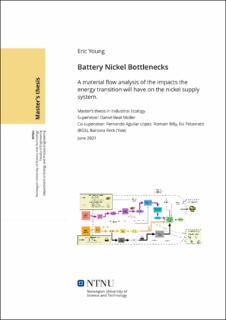| dc.description.abstract | The energy transition is anticipated to create a large increase in the demand for battery grade nickel (Ni) for lithium-ion batteries (LIBs) due to the widespread adoption of electric vehicles (EVs). It is unknown whether Ni manufacturing capacity can meet the demand, and what the unintended consequences of rapid growth might be. This study aims to describe the limitations that the Ni processing infrastructure and technology will have on the timeframe and sustainability of Ni supply. Specifically, identifying potential supply bottlenecks and carbon footprint of the supply system under different development scenarios.
A dynamic material flow analysis model of the Ni system was developed with focus on Ni mining and refining infrastructure, linking the interacting factors of capacity, carbon footprint, environmental governance, and speed of development of different supply pathways of Ni for LIB and non-LIB uses. A range of possible storylines of the future development of Ni supply, battery demand, non-battery demand, and battery recycling were modeled and compared.
The risk of shortfalls was found to be connected to i) sustainability concerns, with likely bottlenecks arising from consumer and regulatory intolerance of the environmental impacts of the fastest developing supply pathways such as nickel pig iron smelting and ii) lack of timely investment in the most well established and green pathways such as sulphide ore refining. The influence of the non-battery supply consumption of Ni was found to have a large effect on both the risk of shortfalls and on the carbon footprint of the battery supply system.
These results suggest that the resilience and sustainability of the Ni industry during the energy transition can be best improved with focus on the Ni supply system as a whole, rather than targeting the battery grade aspects alone to avoid problem shifts. It is found that advanced investment in established and sustainable pathways should be combined with efforts to reduce the environmental impacts of the least sustainable pathways. | |
